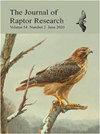Revisiting an Old Issue: Sex Identification of Short-eared Owls (Asio flammeus) at an Asian Wintering Site
IF 1.2
4区 生物学
Q2 ORNITHOLOGY
引用次数: 0
Abstract
At wintering sites of the migratory Short-eared Owl (Asio flammeus) in subtropical Asia, behavioral interactions between males and females are limited, and the body mass and plumage features between the sexes overlap significantly. Thus, sexing the species morphometrically for research and conservation activities is difficult. We aimed to develop a quantitative method for sexing Short-eared Owls, and we here present a new formula to do so using plumage features. We used a total of 198 Short-eared Owls (163 from bird rescue efforts at 15 airports and 35 preserved specimens from a museum in Taiwan) and carefully examined their morphological data and plumage images, then determined their sex using polymerase chain reactions of chromodomain helicase DNA-binding protein genes on sex chromosomes or gonad inspection. Eight of the ten traits we evaluated differed significantly between males and females. Females had a greater number of cross bars on primaries, secondaries, and outermost tail feathers; a higher proportion of yellowish-brown underwing coverage; and larger measurements in head length, bill length, tarsus length, and body mass. The best-fit model suggested simplifying the formula to just the proportion of the yellowish-brown underwing coverage, which provided sexing accuracy exceeding 95.9% for the 49 live individuals in the test data set and 94.3% for the 35 preserved specimens. This formula addresses the challenges posed by ambiguous individuals in the wintering region and offers an efficient and accurate means for sexing Short-eared Owls when DNA or gonad inspection is unavailable.旧事重提:亚洲越冬地短耳鸮的性别鉴定
在亚热带迁徙性短耳鸮(Asio flammeus)的越冬地,雌雄之间的行为互动非常有限,雌雄之间的体质量和羽色特征有很大重叠。因此,在研究和保护活动中很难对该物种进行形态性别鉴定。我们的目标是开发一种用于短耳鸮性别鉴定的定量方法,并在此提出一种利用羽色特征进行鉴定的新公式。我们共使用了198只短耳鸮(其中163只来自15个机场的鸟类救援工作,35只来自台湾一家博物馆保存的标本),仔细检查了它们的形态数据和羽色图像,然后使用性染色体上的染色单体螺旋酶DNA结合蛋白基因的聚合酶链反应或性腺检查来确定它们的性别。在我们评估的 10 个性状中,有 8 个性状在雌雄之间存在显著差异。雌鸟的主羽、副羽和最外侧尾羽上的横条数量较多;翼下黄褐色覆盖的比例较高;头长、喙长、跗长和体重的测量值较大。最佳拟合模型建议将公式简化为只计算黄褐色翼下覆盖的比例,这使得测试数据集中 49 个活体的性别鉴定准确率超过 95.9%,35 个保存标本的性别鉴定准确率超过 94.3%。该公式解决了越冬地区模棱两可的个体所带来的挑战,并在无法进行DNA或性腺检查的情况下为短耳鸮的性别鉴定提供了一种高效、准确的方法。
本文章由计算机程序翻译,如有差异,请以英文原文为准。
求助全文
约1分钟内获得全文
求助全文
来源期刊

Journal of Raptor Research
生物-鸟类学
CiteScore
2.30
自引率
17.60%
发文量
61
审稿时长
>12 weeks
期刊介绍:
The Journal of Raptor Research (JRR) is an international scientific journal dedicated entirely to the dissemination of information about birds of prey. Established in 1967, JRR has published peer-reviewed research on raptor ecology, behavior, life history, conservation, and techniques. JRR is available quarterly to members in electronic and paper format.
 求助内容:
求助内容: 应助结果提醒方式:
应助结果提醒方式:


